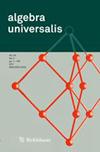On the number of universal algebraic geometries
IF 0.6
4区 数学
Q3 MATHEMATICS
引用次数: 1
Abstract
The algebraic geometry of a universal algebra \({\textbf{A}}\) is defined as the collection of solution sets of systems of term equations. Two algebras \({\textbf{A}}_1\) and \({\textbf{A}}_2\) are called algebraically equivalent if they have the same algebraic geometry. We prove that on a finite set A with \(|A|\) there are countably many algebraically inequivalent Mal’cev algebras and that on a finite set A with \(|A|\) there are continuously many algebraically inequivalent algebras.
关于泛代数几何的个数
泛代数({\textbf{a}})的代数几何被定义为项方程组解集的集合。两个代数({\textbf{A}}_1\)和({-textbf{A}}_2\)如果具有相同的代数几何,则称为代数等价。我们证明了在具有\(|a|\)的有限集a上存在可数多个代数不等价Mal’cev代数,并且在具有\。
本文章由计算机程序翻译,如有差异,请以英文原文为准。
求助全文
约1分钟内获得全文
求助全文
来源期刊

Algebra Universalis
数学-数学
CiteScore
1.00
自引率
16.70%
发文量
34
审稿时长
3 months
期刊介绍:
Algebra Universalis publishes papers in universal algebra, lattice theory, and related fields. In a pragmatic way, one could define the areas of interest of the journal as the union of the areas of interest of the members of the Editorial Board. In addition to research papers, we are also interested in publishing high quality survey articles.
 求助内容:
求助内容: 应助结果提醒方式:
应助结果提醒方式:


